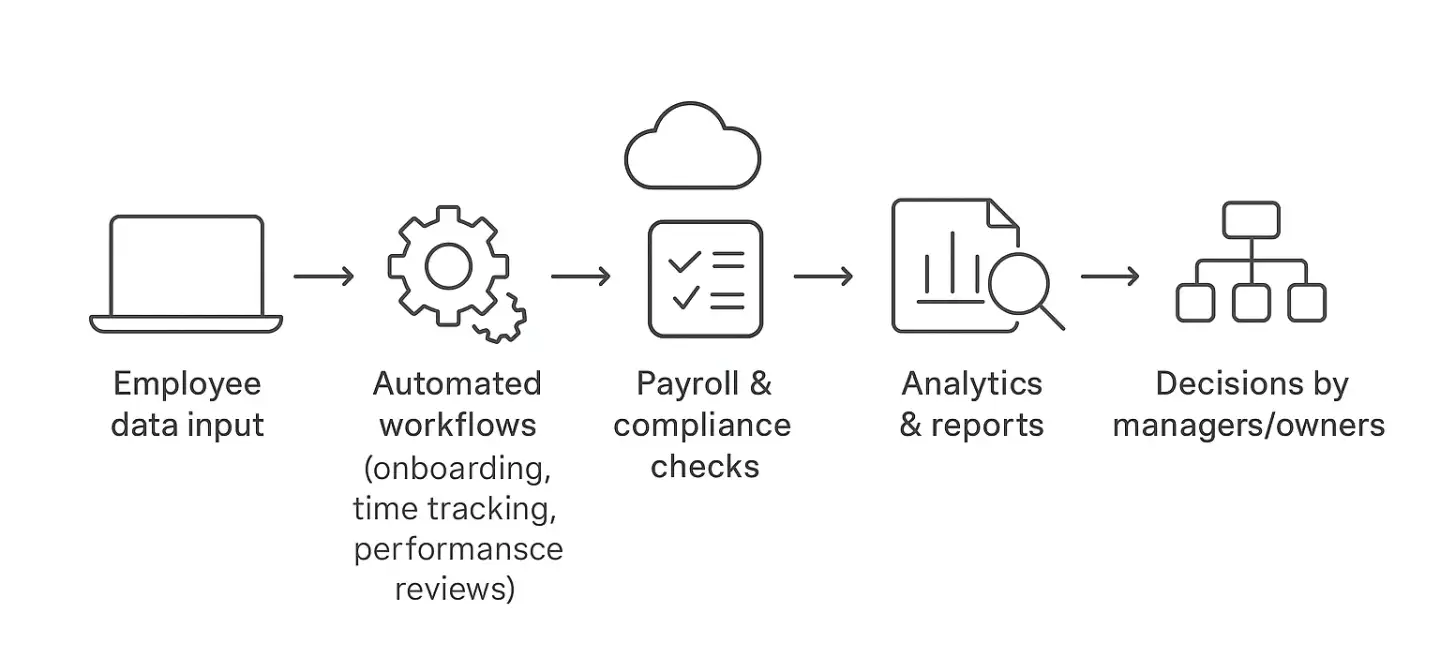We test and review software products using an independent, multipoint methodology. If you purchase something through our links, we may earn a commission. Read about our editorial process.
The best hr platforms in 2025 are desktop/laptop‑first systems that centralize core HR management, payroll processing, talent management, employee data, and compliance in a single cloud dashboard, with mobile app access for quick HR tasks. hr software for small business usually runs on paid, per‑employee plans with full customer support, while free plan tiers limit users and key features (performance management, reporting), fitting only very small teams or short trials.
HR software is desktop/laptop‑oriented, cloud delivery that bundles core HR (employee data, payroll processing, performance management, talent management) and compliance workflows in a single interface. As hr management software for small business, it’s usually sold on paid per‑employee tiers with support and integrations, while free plans cap users and key features, suiting only very small teams or short trials.
Employee data goes into cloud based hr software for small business, which automates HR processes and hr operations—onboarding, time tracking, performance reviews, talent management—through predefined workflows. The platform then pushes the same dataset into payroll processing and hr compliance checks, producing analytics on employee performance and costs for HR management and business owners.

In 2025, small businesses need these core functions to cover HR processes, payroll processing, and compliance without tool sprawl.
Centralized employee data with self‑service so team members update personal information and documents themselves.
Time and attendance management with PTO accrual and audit trails for hr compliance.
Integrated payroll and hr software for small business that calculates taxes, files forms, and supports multi‑state payroll processing.
Talent management hr software for small business covering performance reviews, goals, and basic succession or talent acquisition workflows.
Automated onboarding/offboarding workflows with e‑signatures, policy acknowledgments, and equipment/credential checklists.
Mobile app for managers and employees to clock in, approve requests, and view pay stubs on the go.
Reporting and analytics on employee performance, costs, and core HR metrics for hr team and business owners.
Secure integrations (or API) with accounting, ATS, and collaboration tools to keep hr tasks and finance tasks in a single platform.
US small businesses under 250 employees—startups, agencies, franchises—with distributed or remote teams and contractors need hr software for small and medium business to standardize core HR operations and payroll. A small business owner or lean HR team benefits from online hr software for small business that centralizes data, compliance, and workflows without building a full HR tech stack.
Check these points before you sign - each can add cost or risk.
Hidden add‑ons: payroll runs, benefits admin, onboarding modules, or “premium” customer support billed separately.
Limited jurisdiction: vendors sell hr software for small business uk, hr software for small business canada, or hr software for small business india but skip local tax tables and filings.
No SOC 2, weak GDPR handling, or poor access controls—risk to hr compliance and employee data.
Data lock‑in: no bulk export, restrictive APIs, or penalties for leaving the platform.
Slow, script-only customer support with no SLA, blocking your hr team during payroll processing.
Shallow role permissions and audit logs, mixing finance tasks with core HR tasks.
Mobile app gaps (no time clock, PTO requests, pay stub access) that hinder remote teams.
Vague implementation process or paid “onboarding packages” that inflate total cost.
Most vendors use seat‑based pricing (per employee or active user), while a few offer flat tiers that cap the number of employees; the best hr and payroll software for small business still adds costs for payroll runs, benefits administration, Employer of Record (EOR) services, implementation, and premium customer support. Track these pricing options up front to avoid overruns and to match total cost of ownership to your business needs.
Use this hr software implementation sequence to keep the implementation process controlled and auditable.
Define HR processes, owners, and required approvals before configuration starts.
Export, clean, and map employee data, payroll histories, and documents for accurate data management.
Migrate data, set role permissions, and apply compliance rules (tax, overtime, record retention).
Pilot with a small team to validate workflows and fix gaps before full rollout.
Train managers and the HR team, document SOPs, and set up ongoing support channels.
Automate reporting and alerts for key features (payroll, attendance, performance reviews) and schedule periodic audits.
hr software solutions for small business cut admin hours by automating data management, time tracking, payroll processing, and HR compliance tasks, lowering manual errors and audit risk. Centralized self‑service and clear workflows improve employee experience by giving fast access to pay stubs, PTO, and performance reviews while freeing the HR team for higher‑value HR functions.
Match core features (employee data, payroll/compliance, talent management, reporting), jurisdiction coverage, security (SOC 2/GDPR), integrations, mobile app, and total pricing before you commit. Shortlist 2–3 of the best hr platforms, run parallel trials with real workflows, and pick the hr software for small business that meets requirements with the lowest total cost of ownership.
There is no single “best” pick; match core HR, payroll, compliance, and talent management needs to your budget and region. Connecteam, Gusto, Deel, Remote, and Sage commonly lead shortlists for different use cases (hourly workforces, US payroll, or global employees).
The best software for HR is the one that covers your required HR functions—employee data, payroll processing, performance reviews, integrations—without overbuying. Evaluate feature depth, security, customer support, and total cost against your business needs.
Most vendors price per employee per month; expect low double‑digit dollars for core HR, with extra fees for payroll runs, benefits administration, or Employer of Record services. Implementation, premium support, and add‑on modules can raise total cost of ownership.